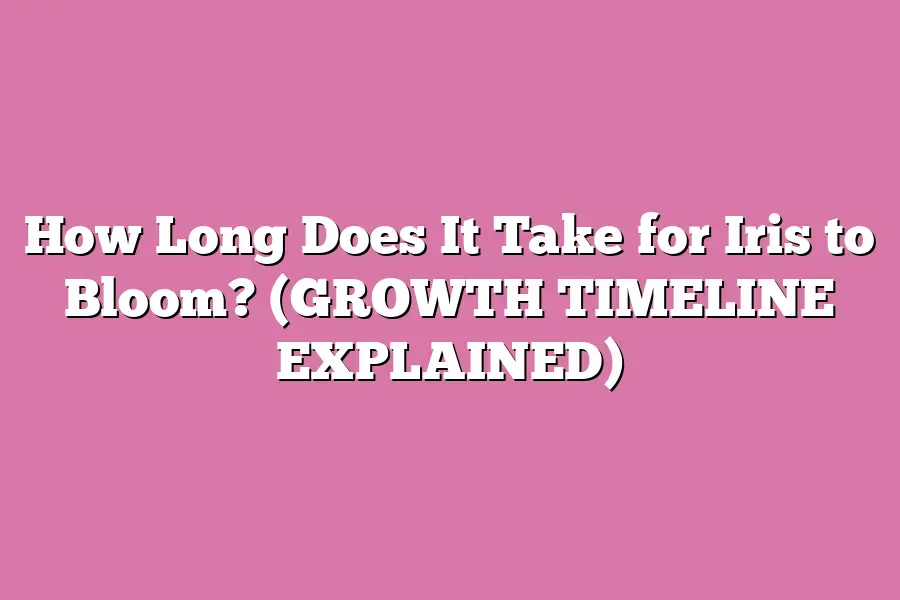Irises typically take about 8 to 12 weeks to bloom after planting. The exact timing can vary depending on the type of iris, environmental conditions, and care provided. Make sure to provide adequate sunlight, water, and well-draining soil to help your irises bloom beautifully and on time.
Step into the enchanting world of iris blooming timelines.
From different iris plant types to the factors influencing their blossoming, unravel the mysteries behind how long it takes for irises to grace us with their stunning blooms.
Explore the fascinating realm of iris growth and uncover the secrets of their mesmerizing transformation from bulb to bloom.
Table of Contents
Types of Iris Plants and Their Blooming Periods
When it comes to admiring the beauty of Iris plants, understanding their blooming periods is key.
Different types of Iris plants have varying blooming schedules, making it important for enthusiasts to know what to expect.
Let’s dive into the different types of Iris plants and when they grace us with their stunning blooms.
Bearded Iris
Bearded Iris, known for their velvety petals and unique beard-like structure, are a favorite among gardeners.
These beauties typically bloom from late spring to early summer.
Depending on the variety, Bearded Iris can bloom for 2-3 weeks, showcasing a wide array of colors ranging from vibrant purples to soft pinks.
Siberian Iris
Siberian Iris, with its delicate and elegant appearance, blooms slightly later than Bearded Iris.
You can expect these graceful flowers to bloom from late spring to early summer, overlapping with the blooming period of Bearded Iris.
Siberian Iris flowers are known for their captivating shades of blue, purple, and white, adding a touch of tranquility to any garden.
Japanese Iris
Japanese Iris, also known as Iris Ensata, are a sight to behold with their large, intricate blooms.
These majestic flowers typically bloom in mid to late summer, making them a standout feature in gardens during the hottest months.
Japanese Iris varieties come in mesmerizing shades of blue, pink, and white, creating a stunning display of color and texture.
Louisiana Iris
Louisiana Iris, native to the southern United States, bloom in late spring to early summer, adding a pop of color to wetland areas.
These vibrant flowers are available in an array of colors, from deep reds to sunny yellows, attracting pollinators and admirers alike.
Dutch Iris
Dutch Iris, also known as Iris Hollandica, bloom in late spring, showcasing their tall, elegant blooms in shades of blue, yellow, white, and purple.
These versatile flowers are popular for both garden beds and floral arrangements, adding a touch of sophistication to any setting.
Understanding the blooming periods of different Iris plants allows gardeners and flower enthusiasts to plan and enjoy a continuous display of color and beauty throughout the growing season.
Whether you prefer the bold hues of Bearded Iris or the delicate charm of Siberian Iris, there’s an Iris variety to suit every preference and garden style.
So, get ready to witness nature’s artistry unfold as each type of Iris plant takes its turn to bloom in all its glory.
Factors Influencing Iris Blooming Time
Have you ever anxiously awaited the moment your iris flowers would bloom, only to find yourself wondering why it’s taking so long?
Well, the timing of iris blooming is influenced by various factors that gardeners should consider.
Let’s explore these factors in detail:
1. Climate Conditions
The climate plays a significant role in determining the blooming time of iris flowers.
Different varieties of iris have their own ideal climate conditions for blooming.
For example:
– Bearded iris varieties generally bloom in late spring to early summer.
– Siberian iris varieties typically bloom a bit later, from late spring to early summer.
2. Sunlight Exposure
Sunlight exposure is crucial for the blooming of iris flowers.
Irises require sufficient sunlight to bloom efficiently.
Lack of sunlight can delay the blooming process.
Ensure your irises are planted in an area where they receive an adequate amount of sunlight each day.
3. Soil Quality
The quality of the soil in which irises are planted can impact their blooming time.
Irises thrive in well-draining soil that is rich in nutrients.
Compacted or waterlogged soil can hinder the blooming process, delaying the emergence of flowers.
Consider amending the soil with organic matter to improve its quality.
4. Watering Practices
Proper watering is essential for the healthy growth and blooming of iris flowers.
Irises should be watered deeply but infrequently to encourage robust root development.
Overwatering can lead to root rot, stunting the blooming process.
Conversely, inadequate watering can cause stress to the plants, delaying blooming.
5. Planting Depth
The planting depth of iris rhizomes can also affect their blooming time.
Iris rhizomes should be planted at the appropriate depth to ensure optimal blooming.
Planting too shallow or too deep can impede the blooming process.
Follow guidelines specific to the iris variety you are planting to achieve the best results.
By considering these factors that influence iris blooming time, you can create a conducive environment for your irises to flourish and bloom vibrantly.
Remember, patience is key when waiting for nature to take its course, but by optimizing these conditions, you can help your irises bloom beautifully and on time.
Stay tuned for more insights on cultivating healthy and thriving gardens!
Understanding the Timeline for Iris Blooming – From Planting to Flowering
When it comes to planting irises, one of the most exciting aspects for gardeners is waiting for these beautiful flowers to bloom.
But just how long does it take for irises to bloom from the moment you plant them?
Let’s dive into the average timeline for iris blooming, including key stages and factors that can influence the process.
1. Planting Stage
The first step in the journey of iris blooming begins with the planting stage.
Once you’ve carefully selected a suitable location with well-draining soil and ample sunlight, it’s time to plant your irises.
On average, irises planted from bulbs can take anywhere from 6 to 8 weeks to emerge from the ground.
2. Foliage Growth
After the irises have emerged from the soil, the next stage involves foliage growth.
During this period, the iris plants will focus on developing their leaves and establishing a strong root system.
Typically, you can expect to see significant foliage growth within 8 to 10 weeks after planting.
3. Bud Formation
As the foliage continues to thrive, the iris plants will start developing buds, a promising sign that flowering is on the horizon.
Bud formation usually occurs around 12 to 14 weeks after planting, depending on factors such as the iris variety, growing conditions, and local climate.
4. Flowering Stage
Finally, the most eagerly anticipated stage arrives – the flowering stage.
Once the buds have fully developed, the irises will burst into a stunning display of colors, marking the culmination of the blooming process.
On average, irises typically bloom within 14 to 16 weeks after planting, although this timeline can vary based on various environmental factors.
Factors Influencing Blooming Timeline
While the average timeline for iris blooming provides a general guideline, several factors can impact this process:
- Climate and Weather: The local climate and weather conditions can influence the rate at which irises bloom.
- Iris Variety: Different iris varieties may have varying blooming timelines, with some flowering earlier than others.
- Soil Quality: The quality of the soil, including factors like drainage and nutrient levels, can affect the overall health and blooming of irises.
the journey from planting irises to witnessing their beautiful blooms is a rewarding experience that requires patience and care.
By understanding the average timeline for iris blooming and the key stages involved, you can better appreciate the beauty of these exquisite flowers in your garden.
Stay tuned for more insights on cultivating irises and maximizing their blooming potential.
Variations in Blooming Time Based on Iris Types
When it comes to the blooming time of irises, various factors influence how long it takes for these beautiful flowers to grace us with their vivid colors.
One significant factor that affects the blooming time of irises is the specific type of iris being grown.
Let’s explore the variations in blooming time based on different iris types:
Bearded Irises
Bearded irises are one of the most popular types of irises due to their striking appearance and unique characteristics.
These vibrant flowers typically bloom in late spring to early summer, with blooming periods lasting around 2 to 3 weeks.
However, the exact blooming time can vary based on the specific cultivar of bearded iris being cultivated.
Siberian Irises
Siberian irises, known for their elegant beauty and graceful appearance, have a blooming time that differs from bearded irises.
These irises generally bloom in late spring to early summer, overlapping with the blooming period of bearded irises.
Siberian irises typically bloom for a similar duration of 2 to 3 weeks, but some cultivars may have longer or shorter blooming periods.
Japanese Irises
Japanese irises are prized for their intricate and exotic blooms that add a touch of sophistication to any garden.
Unlike bearded and Siberian irises, Japanese irises bloom later in the summer, typically in late June to early July.
The blooming period for Japanese irises can extend for 2 to 4 weeks, providing a later burst of color in the garden landscape.
Ensata Irises
Ensata irises, also known as Japanese water irises, thrive in moist, water-rich environments such as along ponds or streams.
These irises bloom slightly later than Japanese irises, usually in mid to late summer.
The blooming time for Ensata irises varies, with some cultivars blooming for 3 weeks while others may bloom for up to 6 weeks, depending on growing conditions and care.
Summary
In summary, the blooming time of irises varies based on the specific type being grown.
Bearded irises typically bloom in late spring to early summer for 2 to 3 weeks, while Siberian irises also bloom during this time frame but may have differing blooming periods.
Japanese irises and Ensata irises bloom later in the summer, providing a colorful display in mid to late summer for 2 to 4 weeks or longer, depending on the cultivar.
Understanding the blooming time variations based on iris types can help gardeners plan their floral displays and appreciate the diversity and beauty that each iris variety brings to the garden landscape.
Whether you prefer the early blooms of bearded irises or the later flowering of Japanese irises, there is a perfect iris type to suit every preference and garden setting.
Final Thoughts
Understanding the timeline for iris plants to bloom is essential for any garden enthusiast.
By exploring the various types of iris plants and their unique blooming periods, as well as factors that can influence blooming time, we’ve gained valuable insights into nurturing these beautiful flowers.
Remember, patience is key when waiting for your iris to bloom, as each type has its own schedule to follow.
So, whether you’re growing bearded iris, Siberian iris, or Dutch iris, embrace the process and enjoy the anticipation of their vibrant blossoms.
As you tend to your iris garden, keep in mind the individual needs of each variety and the impact of planting conditions and climate on their blooming time.
By paying attention to these factors, you can cultivate a thriving garden full of colorful iris blooms.
Now that you’re equipped with knowledge about the average timeline for iris blooming from planting to flowering, why not put it into action?
Take note of the variations in blooming time based on the type of iris you’re growing and tailor your care routine accordingly.
Experiment with different planting methods and environments to see what works best for your iris plants.
So, go ahead and nurture your iris garden with confidence, knowing that you have the insights to support their growth.
Happy planting, and may your iris blooms bring joy and beauty to your outdoor space!

